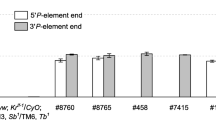Abstract.
To improve the quality of cytoplasmic labelling of GAL4-expressing cells in Drosophila enhancer-trap and transgenic strains, a new GAL4-responsive reporter UAS-tau, which features a bovine tau cDNA under control of a yeast upstream activation sequence (UAS), was tested. Tau, a microtubule-associated protein, is distributed actively and evenly into all cellular processes. Monoclonal anti-bovine Tau antibody reveals the axonal structure of the labelled cells with detail similar to that of Golgi impregnation. We demonstrate that the UAS-tau system is especially useful for studying processes of differentiation and reorganisation of identified neurones during postembryonic development.
Similar content being viewed by others
Author information
Authors and Affiliations
Additional information
Received: 28 February 1997 / Accepted: 10 May 1997
Rights and permissions
About this article
Cite this article
Ito, K., Sass, H., Urban, J. et al. GAL4-responsive UAS-tau as a tool for studying the anatomy and development of the Drosophila central nervous system. Cell Tissue Res 290, 1–10 (1997). https://doi.org/10.1007/s004410050901
Issue Date:
DOI: https://doi.org/10.1007/s004410050901




